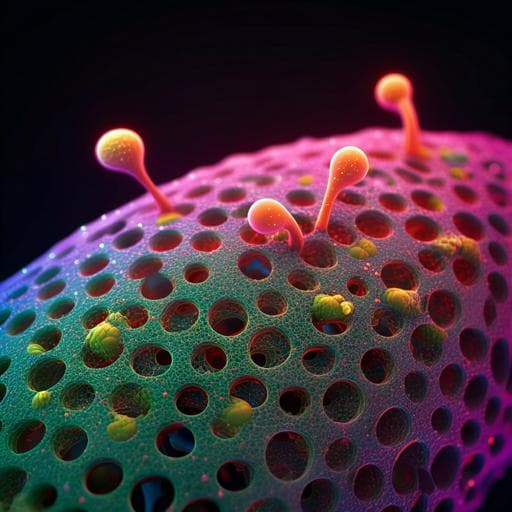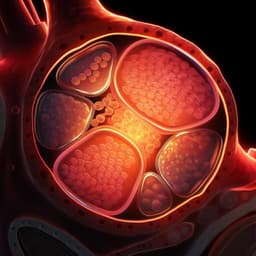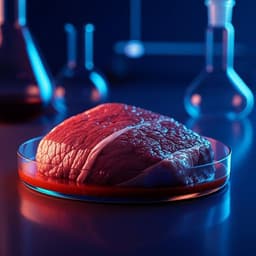
Food Science and Technology
Generation of three-dimensional meat-like tissue from stable pig epiblast stem cells
G. Zhu, D. Gao, et al.
Discover a groundbreaking approach to creating 3D meat-like tissue from porcine pre-gastrulation epiblast stem cells. This innovative study conducted by Gaoxiang Zhu and colleagues showcases a serum-free myogenic differentiation system, paving the way for new cultured meat production techniques.
~3 min • Beginner • English
Introduction
The study addresses key bottlenecks in cultured meat (CM) production: lack of initiating cell lines capable of long-term expansion, reliance on serum and transgenes for myogenic differentiation, and the need for fully edible, non-animal scaffolds that support three-dimensional tissue formation. Rising global demand for animal-origin foods strains livestock systems and impacts sustainability, public health, and animal welfare, motivating alternative food technologies such as CM. Previous initiating cells (mesenchymal and muscle stem cells) have limited expansion and lose differentiation capacity. While immortalized lines exist, mechanisms and safety remain concerns. Stable pluripotent stem cells from livestock could self-renew indefinitely and differentiate into somatic lineages but have been difficult to establish. The authors hypothesize that stable porcine pre-gastrulation epiblast stem cells (pgEpiSCs) can be differentiated into skeletal muscle via defined, serum-free, transgene-free protocols and assembled into 3D meat-like tissues on plant-based edible scaffolds, providing a safer and scalable route for CM.
Literature Review
The paper situates CM within sustainability and food security literature, noting environmental and public health costs of conventional livestock and the promise of CM to reduce impacts. Prior CM efforts used mesenchymal stem cells and MuSCs with limited passages and serum dependence. Immortalized bovine satellite cells and chicken fibroblasts have been explored but with unresolved regulatory mechanisms. Human and mouse PSC myogenic protocols exist, yet extending to livestock remains challenging. Plant-based scaffolds (e.g., textured soy protein, wheat gluten, peanut wire-drawing protein, prolamins, decellularized plants) often required animal-derived adhesion factors (fibrinogen, thrombin, collagen, gelatin). Plant polysaccharide scaffolds have been attempted but often require complex chemical modifications. The authors build on this literature by employing stable pgEpiSCs, adapting myogenic protocols to a fully serum-free, transgene-free system for pigs, and designing ionically cross-linked konjac glucomannan/sodium alginate scaffolds without animal components.
Methodology
- Cell lines and ethics: Stable porcine pre-gastrulation epiblast stem cells (pgEpiSCs) previously established were cultured on mitomycin C-treated mouse embryonic fibroblast (MEF) feeders. Animal procedures were approved by the China Agricultural University IACUC.
- Pluripotency and stability assays: Long-term culture to P200 with colony morphology, alkaline phosphatase (AP) staining, immunofluorescence for OCT4, SOX2, NANOG; alkaline comet assays (H2O2 positive control) for DNA damage; karyotyping; embryoid body (EB) differentiation to assess tri-lineage potential (Tubulin-β, α-SMA, Vimentin markers).
- Transcriptomics: RNA-seq on pgEpiSCs at P30 and P200 vs porcine embryonic fibroblasts (PEFs). HISAT2 mapping to Sscrofa11.1, FeatureCounts quantification, TPM filtering (>0.5), DESeq2 differential analysis, PCA (FactoMineR), ternary plots (ggtern), K-means clustering (k=10) of median TPM time-course, GO enrichment (Metascape), volcano plots (EnhancedVolcano), heatmaps (pheatmap).
- Myogenic differentiation (serum-free, transgene-free): pgEpiSCs dissociated to single cells, feeder removed by resting, plated on gelatin. Early adhesion optimization identified B27 as critical. Induction media (MDM I–V) designed based on WNT activation and TGF-β/BMP inhibition: CHIR99021 (3 µM) to activate WNT, SB431542 (2 µM) to inhibit TGF-β, LDN193189 (0.5 µM) to inhibit BMP; staged media over days (MDM I 3 days; MDM II; MDM III 2 days; MDM IV 4 days; MDM V 20–25 days), then terminal differentiation in N2 supplement without serum. ROCK inhibitor Y27632 (10 µM) added for 24 h post-inoculation. Flow cytometry assessed CD31, CD45, CD56; immunostaining for PAX7, MYOD (progenitors), and Myosin/MF20/MYH3 (mature fibers). Western blots for OCT4, MYH3; qPCR for myogenic maturation genes (MYOG, MYMK, MYH2, MYH3). Fusion index quantified.
- Comparative MuSCs: Porcine MuSCs isolated from 1-week-old pigs (collagenase II/Dispase II digestion, purification by differential adhesion), expanded and differentiated with 2% horse serum; used for benchmarking.
- Metabolomics: Untargeted LC–MS metabolomics of pgEpiSCs vs pgEpiSC-derived mature muscle cells (MCs). Data processed with ProteoWizard/XCMS, Compound Discoverer, PCA/PLSDA/OPLS-DA (IP4M, mixOmics). KEGG pathway enrichment. qRT-PCR for genes related to acetyl-CoA, ATP production, and glycolysis. Assays of ATP (normalized µmol/mg protein), glucose, and lactate.
- Plant-based edible 3D scaffolds: Ionically cross-linked porous scaffolds formed by solution substitution in 75% ethanol containing CaCl2 using konjac glucomannan (KGM) and sodium alginate (SA) mixtures (KGM:SA ratios 9:1 to 1:9). The Ca2+-KGM5-SA5 scaffold was selected based on structure (SEM), water absorption (swelling ratio), degradation kinetics, mechanical stability (compression), inoculation efficiency and viability (>95%) of C2C12 and pMuSCs. Sterilization by 1 kGy ionizing irradiation.
- 3D culture: pgEpiSC-derived myoblasts (stage V) seeded at 1.0×10^6 cells/mL on Ca2+-KGM5-SA5 scaffolds, proliferated 5 days in stage V medium, then 5 days in N2 terminal differentiation medium. Viability by Calcein-AM/PI, proliferation tracking (NLS-GFP reporter), F-actin confocal imaging, SEM.
- Functional and safety assessments: qPCR on 3D constructs (pluripotency down; myogenesis/collagen up), texture profile analysis (TPA) vs blank scaffold and fresh pork, amino acid composition, trace element detection, microbiological testing for foodborne pathogens, karyotype stability after 3D culture. Staining with food-grade pigments and brief frying for appearance tests.
- Data availability and code: RNA-seq (GSE223433), metabolome (OMIX005128), analysis code on GitHub/Zenodo.
Key Findings
- Stable initiating cells: pgEpiSCs maintained pluripotency markers (OCT4, SOX2, NANOG), AP activity, normal karyotypes, and no significant DNA damage through at least 200 passages; RNA-seq showed clustering of P30 and P200 pgEpiSCs distinct from PEFs; cancer-related hallmark genes and splicing factors were not expressed, indicating absence of cancer-like features.
- Myogenic differentiation (serum- and transgene-free): WNT activation (CHIR99021) plus TGF-β inhibition (SB431542), with BMP inhibition (LDN193189) enabled paraxial mesoderm induction and progression to myogenic progenitor cells (MPCs). MPCs co-expressed PAX7 and MYOD; flow cytometry showed a high-purity CD31−CD45−CD56+ population reaching 99.8%. Terminal differentiation in N2 (serum-free) produced multinucleated myotubes expressing MF20, MYH3, with fusion indices and morphology comparable to 2% horse serum. Myogenic maturation markers MYOG, MYMK, MYH2, and MYH3 were strongly upregulated; OCT4 decreased.
- Transcriptomics: PCA and ternary plots showed clear transitions from pgEpiSCs to MPCs to mature muscle cells (MCs). K-means clustering identified stage-specific gene expression modules; GO terms enriched for muscle development, structure, and contraction in late stages; extracellular matrix remodeling corroborated by increased collagen-related genes.
- Metabolomics and energetics: 70 differentially abundant metabolites distinguished pgEpiSCs from MCs (validated by PCA/PLSDA/OPLS-DA). Pathways altered included vitamin B6 metabolism, pentose phosphate pathway, mineral absorption, and protein digestion/absorption. Succinic acid decreased while glucose 6-phosphate increased in MCs. Genes for acetyl-CoA and ATP generation and glycolytic enzymes changed as expected; differentiated cells had significantly higher ATP and lactate production and consumed less glucose.
- Plant-based 3D edible scaffolds: The Ca2+-KGM5-SA5 scaffold exhibited a porous, homogeneous lamellar architecture, high water uptake, low degradation, >95% cell adherence, and mechanical stability. pgEpiSC-derived myoblasts adhered, proliferated, and differentiated into interconnected myofibers on 3D scaffolds, with upregulation of MYOG, MYMK, MYH2, MYH3, COL3A1, COL5A2 and downregulation of OCT4/NANOG.
- Cultured meat prototype: The resulting pgEpiSCs-derived cultured meat (pg-CM) showed improved textural properties vs blank scaffolds, approaching pork benchmarks especially after cooking. Products were free of foodborne pathogenic bacteria, contained conditional essential amino acids, trace elements (Zn, Ca, Mg, K), and had total protein around 3.92%. Cells maintained karyotypic stability.
Discussion
The findings demonstrate that stable porcine epiblast-derived PSCs can serve as robust initiating cells for cultured meat, overcoming limitations of primary MuSCs that lose differentiation capacity upon expansion. A fully serum-free, transgene-free myogenic differentiation pipeline was established for a livestock species, verified at transcriptomic and metabolic levels, which enhances biosafety and potential regulatory acceptance. The study further shows that entirely plant-based, ionically cross-linked KGM/SA scaffolds can support adhesion, proliferation, and maturation of skeletal muscle cells without animal-derived adhesion factors, enabling 3D tissue formation with improved textural properties. Metabolic remodeling toward glycolysis and increased ATP/lactate production aligns with myogenic maturation, validating the differentiation strategy. Collectively, these advances address key CM challenges: initiating cell stability, serum-free processes, and edible scaffolding, providing a framework for scalable and safer CM production.
Conclusion
This work establishes a complete workflow to generate meat-like tissue from stable porcine epiblast stem cells: long-term stable pgEpiSCs as initiating cells, a defined serum- and transgene-free myogenic differentiation protocol, and plant-based 3D edible scaffolds enabling tissue formation. The approach yields mature skeletal muscle fibers with appropriate transcriptomic, metabolic, and structural characteristics, and produces cultured meat prototypes with favorable textural and safety attributes. Future work should focus on simplifying and standardizing the differentiation process for industrialization, reducing media cost via biosynthetic growth factors and food-grade serum substitutes, enhancing scaffold structural/mechanical properties for multi-cell-type co-cultures, and developing large-scale suspension and expansion culture systems.
Limitations
- Process complexity: pgEpiSCs myogenic differentiation is more complex than MuSCs or immortalized myoblast lines, requiring simplification and standardization for industrial processes.
- Cost: Current reliance on commercial, patent-protected stem-cell grade serum substitutes and growth factors limits cost-effectiveness; substantial media cost reductions are needed.
- Scale-up: Large-scale suspension culture and expansion technologies must be developed to meet industrial cell quantity demands.
- Scaffold optimization: Further enhancement of scaffold structural and mechanical properties is needed, particularly for mixed cultures beyond skeletal muscle fibers.
- Mechanistic understanding: Detailed mechanisms of signaling and metabolic pathway modulation during serum-free livestock PSC myogenesis require further elucidation.
Related Publications
Explore these studies to deepen your understanding of the subject.







